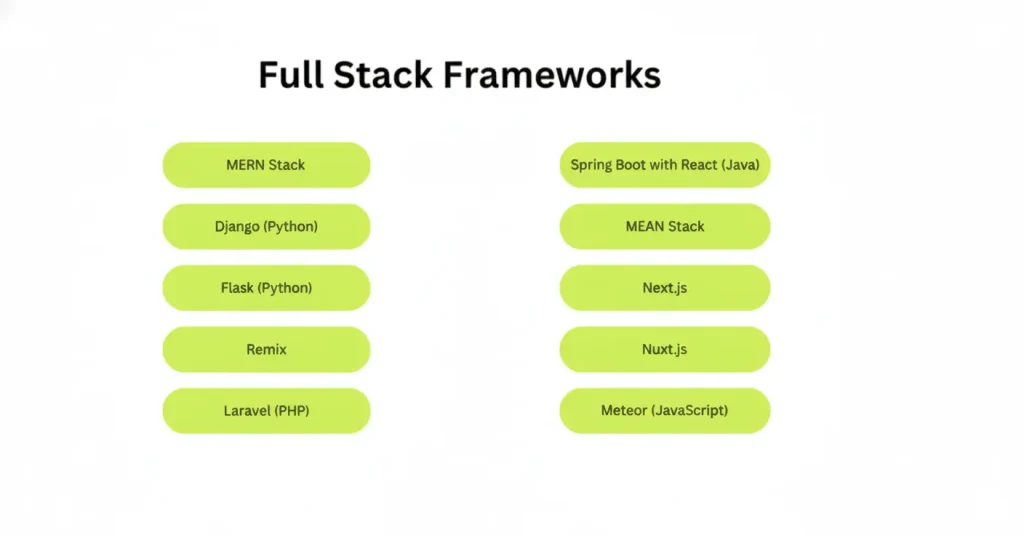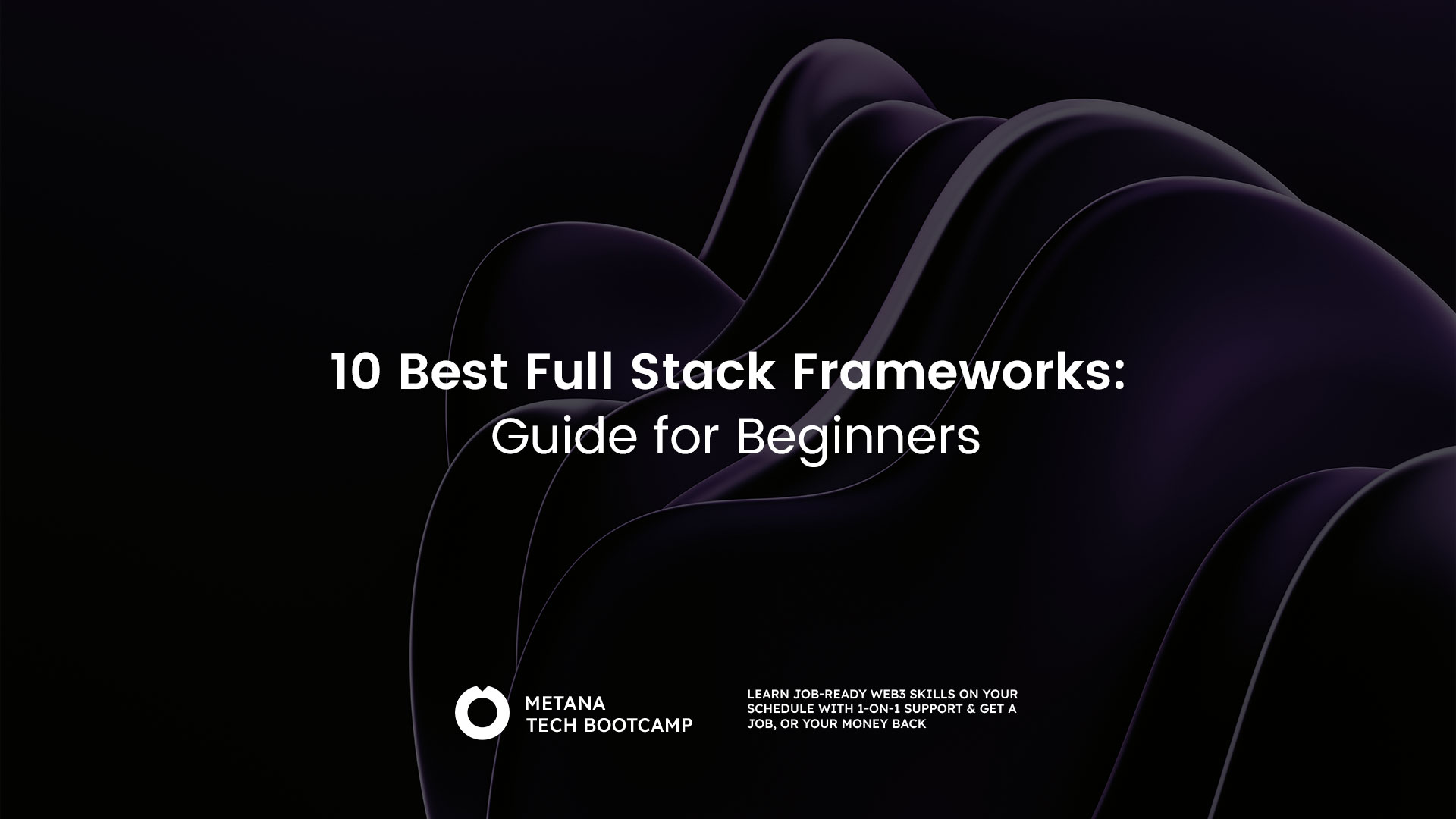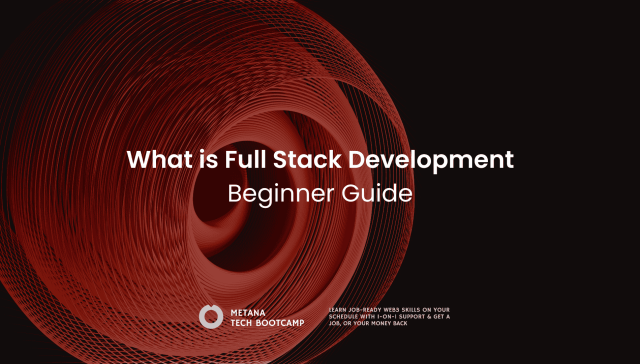TL;DR:
- Full stack frameworks simplify web development by offering tools for both front-end and back-end.
- MERN
JavaScript across the entire stack with MongoDB, Express, React, and Node. Beginner friendly, fast to learn, and ideal for modern web apps. - Django and Flask (Python)
Python based frameworks that simplify backend development. Django offers built in features while Flask provides flexibility for smaller projects. - Laravel (PHP)
Elegant syntax with powerful built in tools. Great documentation and tutorials make it beginner friendly and scalable. - Spring Boot with React
Enterprise grade Java backend with a modern React frontend. Ideal for learning real world scalable systems. - MEAN Stack
Full JavaScript stack using Angular instead of React. Structured, scalable, and well suited for large applications. - Next.js
React based full stack framework with server rendering and API support built in. Excellent for performance and SEO. - Nuxt.js
Vue based full stack framework with simple setup and smooth learning curve for beginners. - Meteor
JavaScript full stack platform with real time features out of the box. Best for rapid prototyping and live applications.
In the tech world, full-stack developers are like all-in-one experts who can work on both the front and back ends of websites and apps, making them super valuable. They’re in big demand because they can do a lot, from making sites look good to making sure they run smoothly.
Full stack frameworks are like magic toolkits for these developers. They have all the tools and guides needed to build websites or apps quickly and without too much trouble. This means developers can create cool stuff faster and easier, while companies can get their products out to people quicker.
What are Full Stack Frameworks?
Full stack frameworks in simple terms, are like big toolboxes for building websites and apps. They help people make the parts you see (like buttons and pictures) and the parts you don’t see (like where the website’s information is kept) work together nicely. It’s like having a set of tools that lets you build a whole toy, not just the wheels or the body, but everything at once.
These frameworks make a developer’s job easier because they come with lots of pre-made pieces. This means a developer doesn’t have to start from zero when they want to build a new website or app. It’s a bit like using a Lego set to build a model — you have all the bricks and a guide on how to put them together.
One of the best things about using a full stack framework is that it lets you use the same language for both the parts you see and the parts you don’t. This makes everything more straightforward and keeps things tidy.
In short, full stack frameworks are great because they:
- Save time: They have ready-to-use parts so you can make apps faster.
- Keep things simple: They let you use the same language for everything.
- Help you do more: They come with tools for checking your work and fixing problems.
These toolboxes are super helpful for people making websites and apps because they make the work quicker, neater, and sometimes even a bit easier.
10 Best Full Stack Frameworks

Let’s consolidate the detailed information into concise paragraphs for each framework to fit into your article structure. This format will make it easier for beginners to grasp the essentials of each full-stack framework.
1. MERN
MERN (MongoDB, Express.js, React, and Node.js) is a popular full-stack JavaScript framework used to build modern, scalable web applications using a single programming language across the entire stack. MongoDB handles data storage with a flexible, document-based database, while Node.js and Express.js power the server side using a fast, non-blocking architecture ideal for high-performance applications.
React manages the front end, enabling developers to build dynamic, component-based user interfaces that update efficiently. MERN is especially beginner-friendly because it removes the need to learn multiple languages and encourages clean separation between front-end and back-end logic. This unified approach helps new developers move faster from learning fundamentals to building real-world applications.
2. Django (Python) and Flask (Python) | Python based full stack framework
Django, is a high-level Python web framework designed to enable rapid development with clean, maintainable code. It follows a “batteries-included” philosophy, providing built-in tools for common web development needs such as user authentication, admin panels, and database management. This abstraction reduces complexity and speeds up web development.
For beginners, Django’s clear structure, extensive documentation, and large community support make it easier to learn and apply. Combined with Python’s readability, Django offers a smooth and approachable entry point into full-stack development while remaining powerful enough for production-grade applications.
3. REMIX
Remix is a modern full stack web framework built on React that focuses on performance simplicity and strong web fundamentals. It emphasizes server first rendering efficient data loading and seamless routing to deliver fast and resilient user experiences. Remix handles backend logic such as data fetching form handling and authentication while using React for building interactive front end interfaces.
For beginners Remix encourages best practices by leveraging standard web APIs and reducing unnecessary abstractions. Its opinionated structure clear documentation and focus on real world performance make it easier for new developers to understand how full stack applications truly work while still being powerful enough for production ready applications.
4. Laravel (PHP)
Laravel is a PHP web application framework that stands out for its elegant syntax and rich feature set, including a robust routing system, an ORM for database operations, and a powerful templating engine. It’s designed to make web development tasks simpler and more enjoyable, offering tools and packages to handle many common challenges effortlessly.
Laravel’s extensive documentation, video tutorial platform Laracasts, and active community support make it a friendly option for beginners. Its emphasis on clean, expressive code and its scalable architecture make Laravel a top choice for both learning and building sophisticated applications.
5. Spring Boot with React (Java Full Stack Framework)
Spring Boot is a robust Java based backend framework built to simplify the creation of production ready applications. It removes much of the traditional configuration overhead by offering opinionated defaults embedded servers and seamless integration with databases security and other enterprise tools. Spring Boot is widely used in real world systems which makes it highly valuable for learners.
When combined with React on the front end Spring Boot manages APIs business logic and data processing while React delivers fast responsive user interfaces. This stack is ideal for beginners who want strong backend foundations exposure to enterprise architecture and the ability to build scalable real world full stack applications using Java.
6. MEAN Stack
The MEAN stack is a full-stack JavaScript framework used to build modern web applications from front-end to back-end using a single language. It combines MongoDB for flexible JSON-based data storage, Express.js and Node.js for fast, scalable server-side logic, and Angular for dynamic, client-side interfaces, all written in JavaScript.
This unified approach simplifies development, streamlines data flow, and makes it easier for developers to switch between layers without learning new languages. Because each component is open-source and well supported, MEAN is a strong choice for learners and teams building dynamic, data-driven apps.
7. Next.js (React Based Full Stack Framework)
Next.js is a powerful React based framework that enables developers to build full stack web applications with ease. It extends React by adding features such as server side rendering static site generation and API routes within a single project. This results in faster performance better scalability and improved SEO.
Next.js handles routing performance optimization and backend logic out of the box reducing setup complexity for beginners. Since it uses JavaScript across both the front end and backend learners can focus on mastering one language. With strong documentation an active community and wide industry adoption Next.js is an excellent choice for beginners building production ready applications.
8. Nuxt.js (Vue Based Full Stack Framework)
Nuxt.js is a full stack framework built on top of Vue.js that simplifies the development of modern web applications. It includes built in support for server side rendering static site generation and backend API handling allowing developers to manage both front end and server logic in one place. Nuxt.js reduces configuration overhead making it easier for beginners to start quickly.
Vue’s clear syntax and component based structure help developers understand application flow naturally. With excellent documentation a supportive community and a gentle learning curve Nuxt.js is ideal for beginners building scalable high performance full stack applications.
9. Meteor (JavaScript)
Meteor is a full-stack platform built on top of Node.js that enables rapid development of web and mobile applications in pure JavaScript. Its real-time capabilities out of the box make it uniquely suited for applications requiring live updates, such as chat apps or interactive games.
Meteor simplifies development by providing a seamless client-server communication layer, allowing for quick prototyping and development. Its integrated ecosystem and isomorphic JavaScript codebase reduce the complexity typically associated with full-stack development, making Meteor an appealing option for beginners looking to build real-time applications efficiently.
How to Choose Your First Full Stack Framework
Picking your first full stack framework is like choosing your first superhero suit. You want it to fit well and help you do amazing things. Here are some tips and things to think about to make sure you pick the best one for you:
Things to Think About
- What You Already Know: If you already know how to speak a computer language, like JavaScript or Python, pick a framework that uses that language. It’s like choosing a superhero suit in your size; it just fits better.
- Friends and Helpers: Look for a framework that has lots of friends; meaning a big community of other people who use it and can help you when you get stuck. The more tutorials, forums, and guides there are, the better.
- Growing with You: Some superhero suits can grow bigger or get stronger as you do. Pick a framework that can handle bigger projects as you learn more. You don’t want to outgrow your suit too quickly!
Tips for Choosing
- Look Around: Before you pick, look at what’s out there. See what other people have made with the framework and check out what learning resources are available.
- Easy to Learn?: Some suits come with a manual that’s easy to read, and some are more complicated. Find out if the framework seems easy for you to learn, or if it’s too confusing right now.
- Jobs and What’s Popular: If you’re learning to get a job as a superhero (or developer), see which suits are most wanted. Some skills are more in demand, and that can help you choose.
- Try It On: If you can, try the framework a little before you decide. Some have demos or playgrounds where you can test them without having to buy the suit right away.
- Think About Your Missions: What kind of superhero do you want to be? What problems do you want to solve? Some suits are better for certain types of missions. Pick one that matches what you want to do.
Choosing your first framework is exciting! It’s like picking your superhero suit. So take your time, think about what’s important to you, and choose the one that feels right. Remember, the best choice is the one that makes you happy and excited to learn and build things.
Conclusion
Full stack frameworks are essential in web development, providing tools for both the front-end and back-end, making building web applications simpler and more efficient. As you venture into full stack development, choose a framework that matches your interests and project needs. Whether it’s MEAN, MERN, or another, starting with projects and practicing regularly will deepen your understanding and skills. Remember, a vast community and numerous resources are there to support you as a beginner. Dive in, explore, and make the most of these opportunities to grow and thrive in the dynamic field of web development with Metana Coding Bootcamps!
FAQs
What are full stack frameworks?
- Full stack frameworks are comprehensive tools designed to facilitate both front-end and back-end development, offering a wide range of built-in functionalities to streamline the web development process.
Can full stack frameworks improve development efficiency?
- Yes, full stack frameworks can significantly improve development efficiency by providing integrated solutions for server-side and client-side programming, reducing the need to switch between different tools and languages.
What are some popular full stack frameworks?
- Popular full stack frameworks include Meteor, MEAN (MongoDB, Express.js, AngularJS, Node.js), and MERN (MongoDB, Express.js, React, Node.js), each offering unique features tailored to different development needs.
How do I choose the right full stack framework for my project?
- Choosing the right full stack framework depends on several factors, including your project requirements, the programming languages you’re comfortable with, and the framework’s community support and documentation.
Are full stack frameworks suitable for beginners?
- Full stack frameworks can be challenging for beginners due to their complexity and the breadth of knowledge required. However, with dedication and the right learning resources, beginners can gradually master these frameworks.
What are the benefits of using full stack frameworks for web development?
- Using full stack frameworks offers numerous benefits, including faster development cycles, consistency across the front-end and back-end, and access to a wide array of built-in features and tools that can enhance productivity and performance.
How do full stack frameworks handle data management?
- Full stack frameworks typically include built-in tools or integrate with external libraries to facilitate data management, offering features for database interaction, data modeling, and CRUD (Create, Read, Update, Delete) operations.
Can I use full stack frameworks for mobile app development?
- Some full stack frameworks, such as Meteor, are designed with cross-platform compatibility in mind, allowing developers to build and deploy mobile applications in addition to web applications.
What are the challenges of working with full stack frameworks?
- Challenges include the steep learning curve for beginners, staying updated with the framework’s evolution, and efficiently integrating front-end and back-end components for a seamless user experience.
How do I stay updated with the latest full stack framework trends?
- To stay updated, follow tech blogs, join relevant online communities and forums, attend web development conferences, and participate in workshops and training sessions focused on full stack development.








